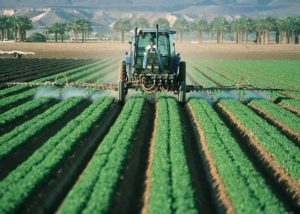Agriculture and livestock bring more and more varied products to men, meeting more and more diverse needs.
However, these agricultural practices are not without consequences for our environment.
Producing more often means polluting more, consuming more.
How can man improve his production while respecting the environment, that is to say by pursuing the objectives of sustainable development?
- Sustainable development and cereal production
The cereal agriculture demands mostly the use of pesticides and insecticides, and the use of agricultural equipment, large fuel consumers.
To limit these negative effects, some environmentally friendly practices can be used by farmers.
-
 Equipment of tractors with GPS
Equipment of tractors with GPS
The GPS (Global Position System) is a device that makes it possible to receive from precise satellite images of the field where the tractor is fitted with such a system.
The use of GPS thus makes it possible:
– to reduce the number of crossings (that is to say the fact of passing in the same place several times) during the working of the ground;
– greater efficiency in the work of tractors, i.e., a 10% reduction in fuel consumption ;
– abetter management of the number of seeds sown ;
– better control, and therefore lower doses of pesticides and insecticides spread in the fields.
- Use of stubble plows
This type of plow buries the humus by turning it over only about 10 cm deep, which preserves flora and fauna of the soil.
The farmer thus spends less time plowing and again saves fuel.
- Seed control
The seeds sown are selected by scientists.
They are earlier, more resistant to disease, and have better nutritional value.
The yields are thus improved.
- Reduction in the area of cultivated land
 Limiting the area of cultivable land and leaving the rest in meadows makes it possible to limit the treatments and doses of pesticides and insecticides.
Limiting the area of cultivable land and leaving the rest in meadows makes it possible to limit the treatments and doses of pesticides and insecticides.
Good crop rotation also reduces the risk of diseases and weeds.
- Sustainable development and milk production
More and more dairy farmers are adopting environmentally-friendly measures.
- Extension of time on pasture
Animals are left on pasture as long as possible: they feed on grass, which costs less to produce than corn, a food given when cows are installing.
In the pastures, we also grow clover, which is capable of capturing nitrogen from the air and transforming it into a nutrient for the meadow.
This avoids the addition of chemical fertilizers. The droppings spread by animals on pasture are sufficient.
- Increase in the area of living spaces
The building that houses cows in winter is called a stable.
The most recent ones allow more cows to be accommodated in a larger, better-ventilated space, sheltered from temperature variations. The cows are thus less stressed and thus produce better quality milk.
The stables are cleaned by scraping robots that collect the manure. The latter is then stored and treated in pits to avoid pollution of water and soil.
- Modernization of milking
Milking cows is now carried out by machines, called milking machines. The milking time being programmed; this saves energy. In addition, these new rooms make it possible to improve hygiene conditions.
